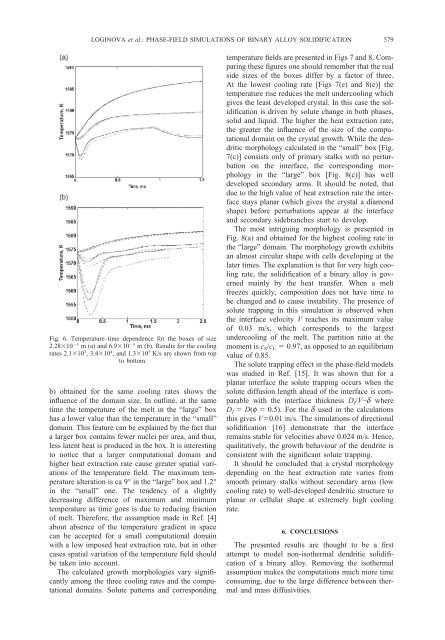Phase-field modeling of diffusion controlled phase ... - KTH Mechanics
Phase-field modeling of diffusion controlled phase ... - KTH Mechanics
Phase-field modeling of diffusion controlled phase ... - KTH Mechanics
You also want an ePaper? Increase the reach of your titles
YUMPU automatically turns print PDFs into web optimized ePapers that Google loves.
LOGINOVA et al.: PHASE-FIELD SIMULATIONS OF BINARY ALLOY SOLIDIFICATION579Fig. 6. Temperature–time dependence for the boxes <strong>of</strong> size2.2810 5 m (a) and 6.910 5 m (b). Results for the coolingrates 2.110 3 , 3.410 4 , and 1.310 5 K/s are shown from topto bottom.b) obtained for the same cooling rates shows theinfluence <strong>of</strong> the domain size. In outline, at the sametime the temperature <strong>of</strong> the melt in the “large” boxhas a lower value than the temperature in the “small”domain. This feature can be explained by the fact thata larger box contains fewer nuclei per area, and thus,less latent heat is produced in the box. It is interestingto notice that a larger computational domain andhigher heat extraction rate cause greater spatial variations<strong>of</strong> the temperature <strong>field</strong>. The maximum temperaturealteration is ca 9° in the “large” box and 1.2°in the “small” one. The tendency <strong>of</strong> a slightlydecreasing difference <strong>of</strong> maximum and minimumtemperature as time goes is due to reducing fraction<strong>of</strong> melt. Therefore, the assumption made in Ref. [4]about absence <strong>of</strong> the temperature gradient in spacecan be accepted for a small computational domainwith a low imposed heat extraction rate, but in othercases spatial variation <strong>of</strong> the temperature <strong>field</strong> shouldbe taken into account.The calculated growth morphologies vary significantlyamong the three cooling rates and the computationaldomains. Solute patterns and correspondingtemperature <strong>field</strong>s are presented in Figs 7 and 8. Comparingthese figures one should remember that the realside sizes <strong>of</strong> the boxes differ by a factor <strong>of</strong> three.At the lowest cooling rate [Figs 7(e) and 8(e)] thetemperature rise reduces the melt undercooling whichgives the least developed crystal. In this case the solidificationis driven by solute change in both <strong>phase</strong>s,solid and liquid. The higher the heat extraction rate,the greater the influence <strong>of</strong> the size <strong>of</strong> the computationaldomain on the crystal growth. While the dendriticmorphology calculated in the “small” box [Fig.7(c)] consists only <strong>of</strong> primary stalks with no perturbationon the interface, the corresponding morphologyin the “large” box [Fig. 8(c)] has welldeveloped secondary arms. It should be noted, thatdue to the high value <strong>of</strong> heat extraction rate the interfacestays planar (which gives the crystal a diamondshape) before perturbations appear at the interfaceand secondary sidebranches start to develop.The most intriguing morphology is presented inFig. 8(a) and obtained for the highest cooling rate inthe “large” domain. The morphology growth exhibitsan almost circular shape with cells developing at thelater times. The explanation is that for very high coolingrate, the solidification <strong>of</strong> a binary alloy is governedmainly by the heat transfer. When a meltfreezes quickly, composition does not have time tobe changed and to cause instability. The presence <strong>of</strong>solute trapping in this simulation is observed whenthe interface velocity V reaches its maximum value<strong>of</strong> 0.03 m/s, which corresponds to the largestundercooling <strong>of</strong> the melt. The partition ratio at themoment is c S /c L 0.97, as opposed to an equilibriumvalue <strong>of</strong> 0.85.The solute trapping effect in the <strong>phase</strong>-<strong>field</strong> modelswas studied in Ref. [15]. It was shown that for aplanar interface the solute trapping occurs when thesolute <strong>diffusion</strong> length ahead <strong>of</strong> the interface is comparablewith the interface thickness D I /Vd whereD I D(f 0.5). For the d used in the calculationsthis gives V0.01 m/s. The simulations <strong>of</strong> directionalsolidification [16] demonstrate that the interfaceremains stable for velocities above 0.024 m/s. Hence,qualitatively, the growth behaviour <strong>of</strong> the dendrite isconsistent with the significant solute trapping.It should be concluded that a crystal morphologydepending on the heat extraction rate varies fromsmooth primary stalks without secondary arms (lowcooling rate) to well-developed dendritic structure toplanar or cellular shape at extremely high coolingrate.6. CONCLUSIONSThe presented results are thought to be a firstattempt to model non-isothermal dendritic solidification<strong>of</strong> a binary alloy. Removing the isothermalassumption makes the computations much more timeconsuming, due to the large difference between thermaland mass diffusivities.
















